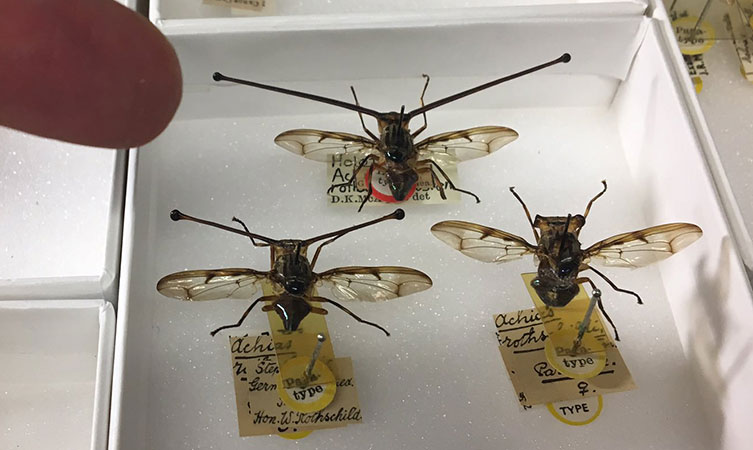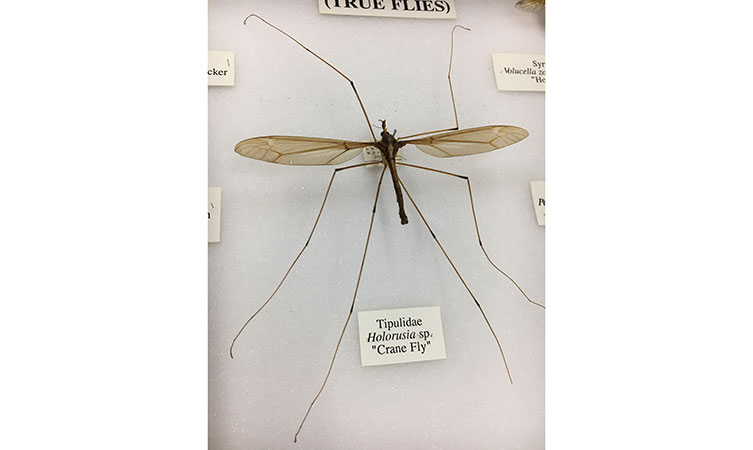Create a list of articles to read later. You will be able to access your list from any article in Discover.
You don't have any saved articles.
Despite a less than stellar public image, flies deserve our admiration, respect and thanks, so Dr Erica McAlister sets out to convince bestselling author and broadcaster Lucy Cooke.
Join them behind the scenes as Erica reveals some of her favourite weird and wonderful fly specimens from the Museum collection.
Although Lucy Cooke 'genuinely loves stick insects more than pandas', she confesses she isn't keen on flies. Brave, when you're talking to Senior Curator of Diptera at the Museum Dr Erica McAlister, whose twitter handle @flygirlNHM says it all.

The Museum collection houses 2.5 million flies, including these Formosia solomonicola specimens
Erica is well-used to defending what she terms 'her babies' and 'the best animals on the planet'. As she shows Lucy behind the scenes to the Museum collection where she is part of a team caring for 2.5 million fly specimens, she has plenty of persuasive arguments at the ready.
Perhaps most compelling is the direct role they have in our lives. Although few of us realise it, without flies and other decomposers we'd be up to our eyeballs in poo and dead bodies.
'Their larvae are cleaning up after us and the adults are pollinating for us. This is why you've got to love a fly,' enthuses Erica.
Even though Erica herself isn't a fan of chocolate, she knows she has a winning argument that will convince chocoholics to show flies some appreciation.
She explains, 'Flies, in particular biting midges, are some of the only pollinators of chocolate on the planet. You get rid of flies, you get rid of chocolate.'
She adds, 'In fact, more than 100 cultivated crops are pollinated by a range of flies, including apples, strawberries, carrots, onions and bell peppers. Not to mention black pepper and coriander.
'Smoothies and stir fries would be far duller dishes without the help of flies.'
Another thing Erica loves about flies, she tells Lucy, is their sheer diversity.
Erica explains, 'The true flies group, called Diptera, has taken its basic body plan - three pairs of legs, a pair of wings, a pair of halteres [modified hind wings used for balance during flight] and sucking mouthparts - and run with it, evolving a phenomenal diversity of shapes and sizes.'
Apart from a few hoverflies that can digest pollen, all true flies have to eat food in liquid form - whether that is nectar, dung, blood or shoe polish. Their mouthparts vary in shape from long, sucking tubes, to disc-shaped 'hoovers'.
One impressive species - Moegistorhynchus longirostris - has the longest proboscis (the fly equivalent of a tongue) in the world relative to its body size.
Erica has worked out that if humans were to have a tongue at the same scale, then it would be an astonishing six metres long!
Erica adds, 'Moegistorhynchus longirostris lives in southern Africa and uses this tongue to get to the nectar deep within a number of different plants with trumpet-shaped flowers, such as the long-tubed iris (Lapeirousia anceps).'

A long proboscis is needed to reach the nectar of the long-tubed iris (Lapeirousia anceps) © Andrew Massyn (CC BY-SA 3.0), via Wikimedia Commons
Among the drawers of flies Lucy looked at during her visit, she thought she spotted a spider. But on closer inspection, this too was found to be a fly - one with a fantastic common name: the terrible hairy fly.
This creature's wings are so small they're useless for flying and its movements - it runs around - are indeed more like that of a spider.

Terrible hairy flies (Mormotomyia hirsuta) may look like spiders, but their three pairs of legs and body parts identify them as insects © Robert Copeland, International Centre of Insect Physiology and Ecology
This fly - Mormotomyia hirsuta - is known from only a few hills in the Ukasi area of Kenya and another location 200km further south. Its larvae feed on bat guano.
'It may be the rarest creature on the entire planet,' adds Erica, although recent expeditions have identified extensive areas of suitable habitat.
Another fly of note is the stalk-eyed fly (Achias rothschildi). Each eye is further away from its body than its body is long.
Eyes on stalks are the fly equivalent of a deer's antlers, and similarly used in mating displays.
Meanwhile, flies in the family Pipunculidae have the largest eyes of all - 'their heads are basically just eyes', says Erica.

A small box of stalk-eyed flies, with a finger pointing at a specimen of Achias rothschildi

Verrallia aucta belongs to the fly family Pipunculidae - its head is nearly all eyes © Dick Belgers (CC BY 3.0)

A Holorusia cranefly in the Museum collection, showing this species' extremely long legs
Verrallia aucta image © Dick Belgers (CC BY 3.0), via Wikimedia Commons
As for long-legged flies - well, anyone who has had to visit an outdoor toilet in autumn has probably cringed away from craneflies seemingly determined to bump into them. But it is a cranefly group from China - Holorusia - that holds the record for the longest legs. Their dangly legs are an impressive 8.5 centimetres long. Like humans, their legs are twice as long as the rest of their body.
This enormous diversity isn't just hidden away in places like the tropics.
'There are more species of fly in the UK than there are mammals on the planet,' states Erica.
Among these are beauties like Bombylius bee-flies, picture-winged flies and the hornet hoverfly (the UK's largest hoverfly species, which reaches almost two centimetres in length).
Even bluebottle and greenbottle flies have their charms - with stunning iridescence that glints like a jewel on a summer's day.
These blowflies are also a forensic entomologist's friends, helping them to narrow down the time of death in murder investigations. Able to detect a dead body from as much as 10 miles away, these insects are often the first to find a corpse. By determining when particular flies found a body, forensic entomologists can provide a minimum post-mortem interval and build up other critical evidence, such as whether the body has been moved.

The common greenbottle fly (Lucilia sericata) has vivid emerald iridescence. Along with bluebottles, these blowflies can provide important evidence in murder investigations.
Another fly that you may find annoying when it's buzzing about your house has spent decades advancing medical science and helping us to understand genetics and inherited diseases and disorders. This is the fruit fly or common vinegar fly, Drosophila melanogaster.
Erica acknowledges some flies have evolved lifestyles that could explain our dislike of these insects.
A horsefly bite is very painful, as anyone who has ever experienced one will attest. Mosquitos not only drive us crazy with their buzzing but spread one of the world's biggest killers: malaria. And botflies have a life cycle that could turn even the most hardy stomach: their larvae burrow into the skin or digestive tracts of various mammals, including humans.
But even these flies should inspire admiration - at least among those not on the receiving end - for their survival skills and the sheer genius of their adaptations.
Erica adds, 'The botflies are rather amazing in the fact that the human botfly is not the creature that approaches us - instead she uses a horsefly or a mosquito to transfer her offspring to us!'

This magnified head of a female mosquito (artificially coloured) shows the long proboscis that she uses to suck blood during egg production and to feed on nectar at other times
As for horseflies and mosquitoes, it's only a minority that bite us.
Erica explains, 'The females of both horseflies and mosquitoes only blood feed for egg development. The rest of the time they, and the males, are nectar feeders and thus pollinators. In fact, there are long-tubed horseflies (much like M. longirostris) that are critical pollinators.'
All these flies also form an important part of ecosystems, a key food source for many other animals higher up the food chain. As a whole, the benefits of flies surely outweigh their drawbacks.
Erica concludes, 'Flies are some of the most diverse and exciting animals to study but there is still so much to understand.
'We very much need everyone's help to learn more about these fascinating creatures. For example, there are many Diptera recording schemes people can contribute to, helping us to monitor the distribution and seasonality of various groups. A good one to start with is Bee-fly Watch.'
And what about Lucy, is she a fly convert?
'Who needs science fiction when you have flies to study?' she declares. 'They are a stunning example of the power of evolution to manifest fabulously strange solutions to the question of life.
'I'm still not convinced about playing host to a botfly, but I am certainly in awe of their extraordinary diversity.'